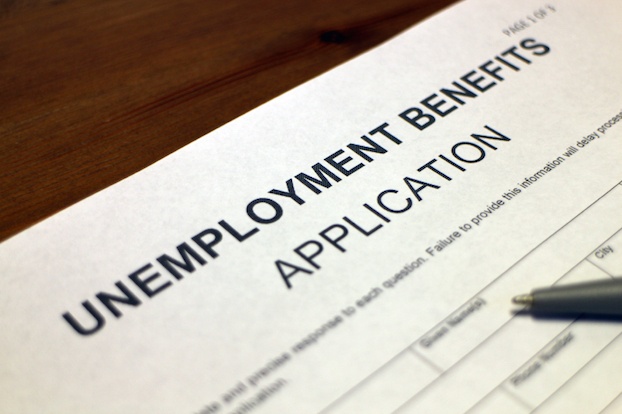
More than 22 million Americans have filed for unemployment aid since President Donald Trump declared a national emergency four weeks ago, a staggering loss of jobs that has wiped out a decade of employment gains and pushed families to line up at food banks as they await government help.
The United States has not seen this level of job loss since the Great Depression, and the government is struggling to respond fast enough to the deadly coronavirus health crisis and the widespread economic pain it has triggered.
Layoffs are mounting in nearly every sector as businesses have been forced to close due to the shutdowns to stem the spread of covid-19, the disease caused by the novel coronavirus. Many companies that remain open reported a massive drop-off in sales. New data shows that manufacturing production cratered in March by the most since 1946, and new home construction saw the biggest decline in nearly 40 years.
“We are going to go through a couple of quarters, at least, where things will be bad,” said Patrick Harker, president of the Federal Reserve Bank of Philadelphia. “I could see a [jobless] number hovering around or slightly below 20%, even.”
Government aid has been slow to arrive for many Americans, exacerbating the downturn. The Small Business Administration stopped accepting loan applications on Thursday after it ran out of funds for a key program that’s supposed to help businesses stay afloat and retain workers.
State unemployment offices are so overwhelmed that many people are still waiting for unemployment payments weeks later and few states have done anything yet for the self-employed and gig workers who are desperate for aid. Even the federal government’s relief payments – referred to by many as “stimulus checks” – have been held up by various glitches. About half of the payments have gone out so far.
Stocks were little changed Thursday as Wall Street investors had already factored in massive job losses, but the stock market has rallied in April on hopes that parts of the global economy can reopen soon. Trump has pointed to the rally as evidence that he is doing a good job handling the crisis, though the Dow Jones industrial average remains in a bear market – down more than 20% from its February high.
“If we weren’t doing well, the market wouldn’t be at a level that it is today,” Trump said Tuesday.
Last week, 5.2 million people filed unemployment insurance claims, the Labor Department reported Thursday, making it among the biggest spikes ever, though that is less than the 6.6 million people who applied the week before and the record 6.9 million people who applied the week that ended on March 28.
Thejob losses in the past month have erased virtually all of the 22.8 million jobs gained since 2010 as the nation rebounded from the Great Recession.
Two economists say the U.S. unemployment rate is already over 20%, according to Alexander Bick of Arizona State University and Adam Blandin of Virginia Commonwealth University, who are tracking the data in real time. It is expected remain close to 10% through the end of the year, meaning 1 in 10 people would still be out of work during the end-of-year holidays, the National Association for Business Economics says.
Every state has experienced job losses, with several key swing states in the upcoming presidential election among those hit hardest with layoffs ranging from manufacturing to hospitality. In Michigan, a million workers, or 21% of the workforce, applied for unemployment over the past month.
Pennsylvania has close to 20% of workers out of a job, and Ohio is near 15%. The state most affected is Hawaii, which has a nearly 22% unemployment rate because the tourism industry has been devastated.
These devastating jobless numbers have played a key role in Trump’s intensifying push to reopen the economy. The White House on Thursday released new guidelines putting those decisions in the hands of states, but Trump reiterated his optimism that the lock downs will end soon.
“We must have a working economy, and we want to get it back very very quickly, and that’s what’s going to happen. I believe it will boom,” Trump said in a news conference.
Even after parts of the economy reopen, people are going to remain fearful of venturing out again to restaurants or offices unless there is widespread testing or a vaccine, many experts say.
In addition to health concerns, Americans typically slash their spending when they see widespread job losses and pay cuts among their friends and family members, another issue likely to prevent a rapid recovery.
“Households are spooked by the idea that they might lose their jobs again or have their hours cut again. They see so many different ways their lives can get disrupted,” said economist Ernie Tedeschi of Evercore ISI, a research firm. “They are not going to be confident that things are back to normal until well after the virus has passed.”
Tedeschi, a former Treasury Department official, said the psychological effects of so many job losses are likely to be long-lasting. He pointed to how millennials have been reluctant to buy homes, years after the Great Recession, because they are still spooked by seeing so many family members and friends experience foreclosure or personal bankruptcy.
The 22 million jobless figure is likely an understatement because most gig workers and temporary employees have not been able to apply for aid yet.
“Once one adds in those not captured by the data, we are almost certainly facing a 20% unemployment rate now,” said Joseph Brusuelas, chief economist at audit firm RSM. “At this point in the pandemic, roughly 1 in every 7 individuals in the workforce is unemployed.”
Nineteen states are accepting applications from gig workers and others who normally don’t qualify for traditional aid but are supposed to get the $600 a week pandemic unemployment that Congress approved in March, according to Employ America, which is tracking the state unemployment office problems closely. The remaining states won’t accept applications until later this month or in May.
Amanda Fleming lives in Virginia, which is not accepting unemployment applications yet from self-employed workers.
Fleming and her husband run a tree-cutting business. They have not been able to apply for unemployment. Their Small Business Administration loan has not come through, and they were among millions of Americans who found out this week that their stimulus check is delayed.
“Just any help soon would be nice. My son’s prescriptions are coming up soon for renewal,” said Fleming, a Clintwood resident. “I know it’s not anybody’s fault, but it’s just a mess.”
The Fleming family told its landlord that it would pay the other half of the rent this week after a stimulus check came through, but now it does not know when the money will arrive. Fleming borrowed money from family members to buy groceries this week. She spoke to The Washington Post on her way home from the grocery store.
Their tree cutting business doesn’t have employees, but several people in the area work with it as independent contractors. Some have called Fleming asking for money because they are also in need and have yet to receive the government’s financial help.
“We don’t know how long this is going to last,” Fleming said. “Our contract workers are looking at us right now, too. What should we do? I’ve even had some of them ask for money because they are in the same situation.”
(c) 2020, The Washington Post · Heather Long
{Matzav.com}











